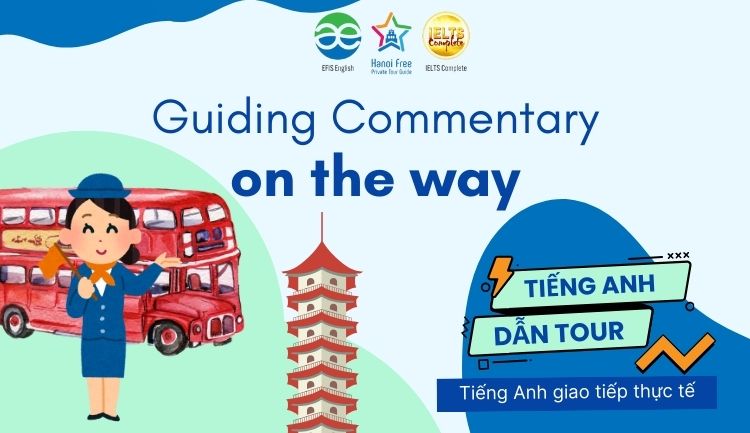Tiếp tục chuỗi bài về từ vựng du lịch tiếng Anh dẫn Tour, Efis English sẽ hướng dẫn bạn về Guiding Commentary on the Way. Làm thế nào để kết nối với khách và có những cuộc đối thoại thú vị, chúng ta cùng tìm hiểu trong bài học này nhé.

Các mẫu câu từ vựng du lịch cần nắm
Đối với các từ vựng du lịch cần nắm trong bài học này, thông thường thì trên đường đến đích, hướng dẫn viên du lịch có thể thông báo rất nhiều điều đến khách. Chúng ta có thể nhận xét về các điểm tham quan bên đường, cột mốc, tình trạng đường, ùn tắc giao thông, tai nạn giao thông, đường bị chặn, làm đường, xem trước các điểm tham quan hoặc địa điểm yêu thích để tham quan và đánh giá chúng. Hướng dẫn viên cũng sẵn sàng cung cấp bất kỳ thông tin lịch sử, chính trị hoặc (thông tin cơ bản) nào khác, những câu chuyện cười cho khách du lịch.
- It will take … minutes to go to …: Sẽ mất … phút để đi đến …
- Now we are approaching…: Bây giờ chúng ta đang đến gần…
- We are now directing south.: Bây giờ chúng ta đang hướng về phía nam.
- We are now directing north to … :Bây giờ chúng ta đang đi về phía bắc để…
- We are heading west.: Chúng ta đang đi về phía tây.
- On our left is … and our right side is …: Bên trái của chúng ta là… và bên phải của chúng ta là…
- On your right, we can see …: Ở bên phải của bạn, chúng ta có thể thấy…
- If you look over to the right now you can see …: Nếu bạn nhìn sang bên phải bây giờ bạn có thể thấy…
- Alright, now we are on Tangkuban Perahu Mountain.: Được rồi, bây giờ chúng ta đang ở trên núi Tangkuban Perahu.
- We are now entering Jl. …: Bây giờ chúng ta đang vào Jl.…
- We have here on your left …: Chúng ta có ở đây bên trái của bạn…
- Ladies and Gentlemen, in front of you is …: Thưa quý vị, trước mặt quý vị là…
- On the same side we also have …: Đồng thời chúng ta cũng có…
- We are approaching a very attractive …: Chúng ta đang tiếp cận một điều rất hấp dẫn…
- We will be here for … hours.: Chúng ta sẽ ở đây trong… nhiều giờ.
- Welcome to ...: Chào mừng bạn đến…
- I welcome you …: Tôi chào mừng bạn…
- Now ladies and gentlemen, we are arriving at …: Bây giờ, thưa quý vị, chúng ta đang đến…
- It is time to get off the bus.: Đã đến lúc phải xuống xe buýt.
- Watch your step.: Hãy cẩn thận bước đi của bạn.
- Mind your head.: Hãy chú ý đến cái đầu của bạn.
- Be careful with your steps.: Hãy cẩn thận với các bước của bạn.
- Oh, ooph, it is a bit slippery. Are you alright?: Ôi, nó hơi trơn. Bạn có ổn không?
- Oh my God, look at your right. It is an accident.:Ôi Chúa ơi, hãy nhìn sang bên phải của bạn. Đó là một tai nạn.
- Before we start, I’d like to tell you about the route: Trước khi chúng ta bắt đầu, tôi muốn kể cho bạn nghe về lộ trình
- Our visit of today will last …: Chuyến thăm của chúng ta ngày hôm nay sẽ kéo dài…
- Thank you for your attention ladies and gentlemen.: Cảm ơn sự quan tâm của quý vị và các bạn.
Mẫu bài đọc cũng cố từ vựng tiếng Anh dẫn Tour
Để có thể hình dung những mẫu câu đã học ở trên vào bối cảnh, chúng ta hãy cùng tìm hiểu thông qua bài đọc ngay sau đây.
On the way from Tangkuban Perahu to Sari Ater
How was the view of Tangkuban Perahu? Did you enjoy it? Now we will continue our trip to Sari Ater. On your right and left side you can see a beautiful tea plantation just like wide green mattress on the flanks of the mountain. Almost everybody drinks tea, don’t they? By the way, does anyone know when tea started to be grown in this area and how tea is produced? Alright then let me tell you.
Before the city of Bandung was founded, in the beginning of the 19th century, the Dutch people had already begun cultivating the upper flanks of its surrounding ring of mountains with tea and coffee plantations as early as 1810. More than 80 separate plantations were in operation by 1902. Indonesia together with other countries such as India, Japan, China and Kenya produce 85% of the world’s tea production. Most of tea plantations in Indonesia are now run by local government and the number of private ones is marginal. However, around 70% of our production is exported. The tea trade here is based mostly on green and black tea. The green tea which is sold domestically is relatively simple to produce while the black one which requires more intensive procedure is mostly for export.

Telling how to produce tea
Look, down there on your right some people pick tea leaves. Let me tell you how to produce tea. First, the freshly picked green leaves are spread out to dry on ventilated trays.
During this process, approximately 30% moisture is extracted from the leaves, making them soft and pliable for further processing. The leaves are then rolled by applying mechanical pressure to break up the cells and extract the cell sap. After 30 minutes, the leaves, still damp from the sap, are sieved to separate the finer leaves. These are spread out immediately for fermentation, while the remaining coarse leaves are rolled for a further 30 minutes under higher pressure. If necessary, this process is repeated several times. A short rolling time produces larger leaf grades, while longer rolling breaks the leaves up more resulting in smaller grades. During the rolling process, the cell sap runs out and reacts with oxygen, thus triggering the fermentation process. At the same time, the essential oils responsible for the aroma are released.
After rolling, the tea is spread out in layers approximately 10 cm high for one to three hours in a cool, damp atmosphere to finish off the fermentation process. During this process, the substances contained in the cell sap oxidize. In this production phase, the green leaf gradually turns a copper color. The color and typical odor tell the person supervising the process how far the fermentation has progressed. Various chemical reactions cause the leaf to heat up during fermentation. It is critical for the quality of the tea that the fermentation process be interrupted at its peak, when the temperature is at its highest.

Next, the tea is dried with hot air at a temperature of approx. 85º-88ºC in order to interrupt the oxidation process. The residual moisture is thereby extracted from the leaves, the extracted sap dries on the leaf and the copper-colored leaf turns dark brown to black.
Finally, the dried tea is sieved to separate the different leaf grades. The orthodox production method provides teas of all leaf grades: leaf, broken, fanning and dust. Leaf grades only refer to the leaf size, however: they are not necessarily an indication of the quality of the tea (Petit
Tea, 2016).
If you are interested to see how tea is produced, we can help you to arrange another visit sometime. We are now very close to Sariater. Yes, we are entering the parking area and please be ready to get off the bus. Here we are Sariater. We’ll be here for two hours and before leaving we’ll have lunch at 12.30. here at Sariater restaurant. Watch you steps and mind your head.
Thông qua bài học về từ vựng du lịch Tiếng Anh dẫn Tour về Guiding Commentary on the way, hy vpngj bạn sẽ không những học thêm được các mẫu câu mà còn học được thêm một số cách làm sao kết nối với các vị khách dễ thương của mình nữa nhé. Nếu có bất kỳ thắc mắc gì thì hãy bình luận phía dưới để Efis English giải đáp giúp bạn nhé.
Nếu bạn quan tâm khóa học tiếng Anh dẫn tour giao tiếp thực tế của Efis English, hãy đừng chần chừ mà nhắn ngay cho tụi mình nhé!
————————————————————————————–
Efis English – Hanoi Free Private Tour Guide
✯ https://efis.edu.vn/
♟185 Chùa Láng, Đống Đa, Hà Nội
☎ 0961.764.299
☞ efisenglish@gmail.com
✤ Fanpage IELTS: IELTS Complete – IELTS Toàn diện
✤ Fanpage EFIS ENGLISH: EFIS English – Học tiếng Anh thực tế
✤ Fanpage HANOI FREE PRIVATE TOUR GUIDE:
Hanoi Free Private TOUR GUIDE – Dẫn tour cho người nước ngoài Học tiếng Anh
✤ Group luyện thi IELTS: Cùng luyện thi IELTS
Có thể bạn quan tâm:
Từ vựng chủ đề du lịch | Preparing Tour Itineraries
Từ vựng chủ đề Travel | Tiếng Anh dẫn tour 4: Orientation Meeting and Briefing




